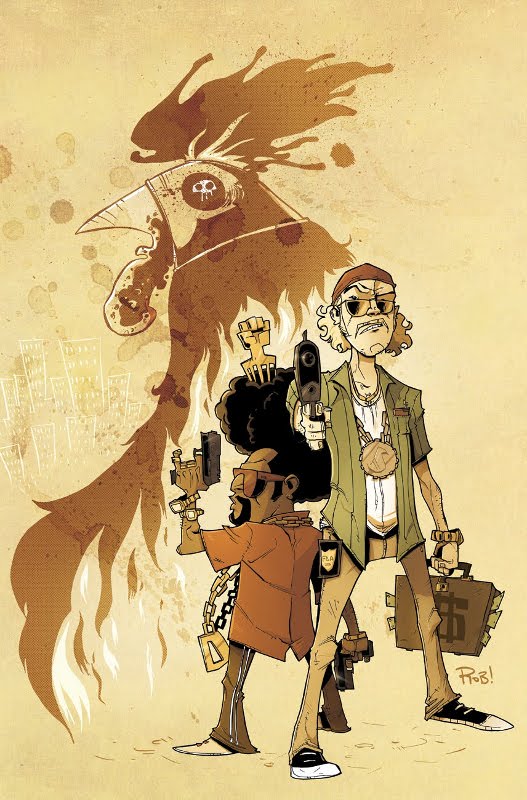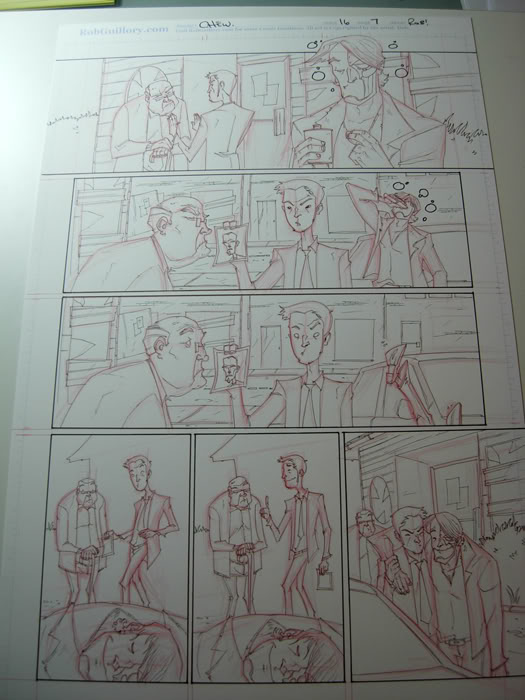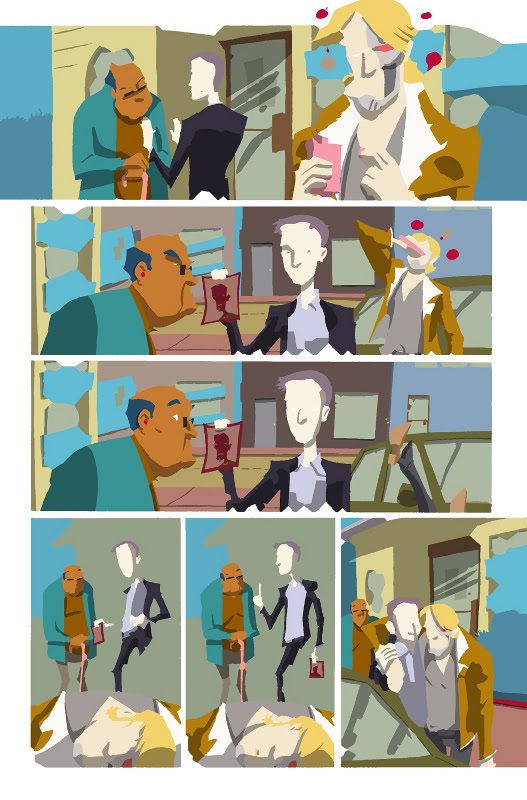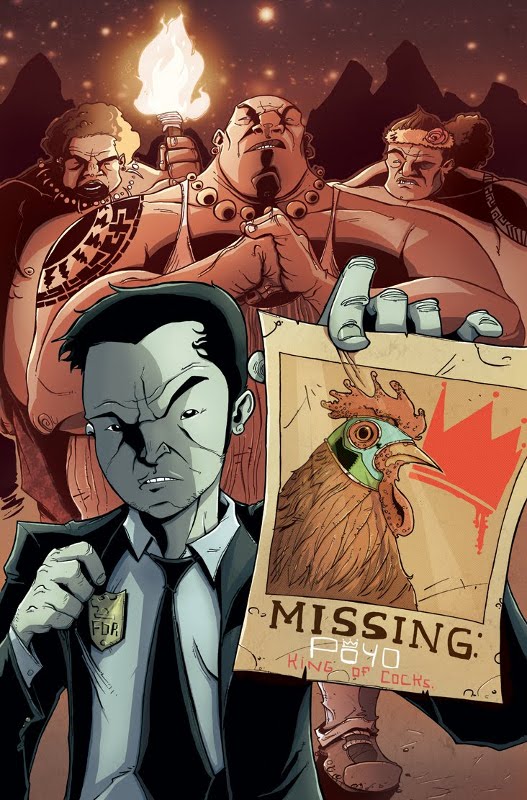 Coinciding with the german release of Chew, we did not only chat with writer John Layman, but also with artist and co-creator Rob Guillory. Talking to Thomas Koegel via Instant Messenger, Rob told us how he got the job, how an issue of Chew is made and why he likes creator-owned comics so much more than company-owned superhero books.
Coinciding with the german release of Chew, we did not only chat with writer John Layman, but also with artist and co-creator Rob Guillory. Talking to Thomas Koegel via Instant Messenger, Rob told us how he got the job, how an issue of Chew is made and why he likes creator-owned comics so much more than company-owned superhero books.
[Hier geht’s zur deutschen Version.]
CG: Rob, for most comics readers (including myself), the first time they saw any of your work, was the first issue of Chew. Can you tell us a little bit about your education and your career before Chew?
RG: Yeah. I’ve been drawing comics since I was a kid, and growing up in Lafayette, Louisianna, it didn’t seem like a „real job“ that you could aspire to attain. So I enrolled in the University of Louisiana for five years, focusing on a painting degree. And during that time, I was the senior cartoonist at the school’s newspaper, The Vermilion. I did two weekly strips for five years, which was a great exercise. It taught me to work within a deadline. And on top of that, I was going to comic conventions fairly regularly, about twice a year. I was meeting pros and building a network, so that when I graduated I would have something to go to. I graduated in 2005, and started getting (barely) paying work a year later.
I did a bunch of indie stuff that no one’s heard of. 100+ pages of a creator-owned collaboration that’ll never be published. Teddy Scares for Ape Entertainment. Some work for Randomhouse UK. And some unpublished stuff at Tokyopop. But yeah, Chew’s the first major thing that I’ve done.
CG: And that Tokyopop project brought you together with John Layman somehow …
RG: Yeah. I worked with a writer named Brandon Jerwa at Tokyopop, who’s a good friend of Layman’s. So when John was looking for an artist, Jerwa referred me.
CG: John told me that the first scripts were already written when you came on board. What about character designs? Did anything exist before or was it all done by you?
RG: All John had were the first three scripts. So I designed everything from there. In fact, John felt that my voice was so obvious in the art design that he made me co-creator despite the fact that he’d conceived of Chew before me. Very flattering.
 CG: I think he’s right. The artwork is such an integral part of Chew. When you design a new character, be it for Chew or anything else, what’s your way of doing that?
CG: I think he’s right. The artwork is such an integral part of Chew. When you design a new character, be it for Chew or anything else, what’s your way of doing that?
RG: With Chew, I asked if John had actors in mind, and he did. For example, Orson Welles as Savoy. That gave me a starting point with which to twist and exaggerate the character design.
CG: Chew is a pretty wild ride. It touches a lot of genres, it is funny and creepy and thrilling at the same time, and sometimes a little gross or disgusting. Can you imagine anything you wouldn’t draw because it’s just too much?
RG: Yeah, I have lines that I won’t cross. Thankfully, John has many of the same lines and has been surprisingly sensitive about what gets into the book. Explicit sexual stuff won’t get in. All gross stuff in the book serves the story. We’re not excessive for the sake of being excessive.
CG: What aspects of (or characters in) Chew are your favorite ones to draw, and which ones would you rather avoid?
RG: Tony, Savoy and Colby are always really fun to illustrate, because they’re very expressive characters. Any action stuff is always a blast, and John gives me a lot of it. I can’t really think of anything that I explicitly hate doing in the book. I look at every page as a problem to be solved. I guess pages with heavy, heavy dialogue are a pain, and a bit boring. But that’s the worst I can come up with.
CG: What I really love about Chew are the cool and original ideas in the way the story is told, especially the page layouts and the way the reader is guided from panel to panel. Is that already in John’s scripts or are these your ideas?
RG: Both. John’s got great design sense, so he comes up with great layout ideas all the time. But he’s always open to my ideas if I feel that I have a better way of telling it. His scripts literally talk directly to me and they usually say „I picture this scene like this, Rob, but if you have a better idea, go for it.“

 CG: As for your collaboration: John sends you the script for a new issue of Chew – what happens next? Can you guide us through the process of creating an issue of the series?
CG: As for your collaboration: John sends you the script for a new issue of Chew – what happens next? Can you guide us through the process of creating an issue of the series?
RG: We’re roughly on a five-week rotation for each issue. He shoots me a script months before I even start the issue. I read it a handful of times, then start breaking each page down into puzzle pieces, basically. I divide up each page depending on what each panel needs. From there, I do rough thumbnail sketches of each page. I solve about 90% of the design problems at this stage. Then, I do rough pencils with red graphite on 11×17 bristol board. My pencils tend to be really loose and gestural, more than tight and detailed. From there, I tighten them up, add little details and whatnot. Then I ink using a combination of pens and brushes. And after inks, I usually add a bunch of little Easter eggs to each page. Just a little extra level of interaction for the reader. Jokes, cameos or whatever.
From there, I scan the page in, format it to the Image Comics template, and roughly draw out shadows and lighting. Then I send it to Steven Struble, who color-separates each page according to my guides. After that, he sends the page back to me, and I fine-tune shadows, lighting and effects. So each page takes about six to eight hours from pencils to inks. Another three to four for colors. Then, I send the finished art to John, and he letters the work. Then he shoots it off to Image and that’s it.
 CG: When I chatted with John, he said: „Rob is the quiet, professional, straight-edged friendly one. I am the hard-drinking, overly opinionated jackass.“ Is he right?
CG: When I chatted with John, he said: „Rob is the quiet, professional, straight-edged friendly one. I am the hard-drinking, overly opinionated jackass.“ Is he right?
RG: HA. Sometimes. John is way harder on himself than he should be. My wife and I hung with John for a week in Italy last year, and he’s an amazingly kind and considerate guy. The fact that he recognized my contribution and made me co-creator after the fact points to his integrity. I don’t know ANY other creator with that level of integrity. That’s why he’s the only guy I ever want to work with.
CG: „Creator owned“ vs. „company owned comics“ is quite a hot topic at the moment. I’m sure you heard about the new initiative spearheaded by Eric Powell. What do you think about this subject?
RG: I respect mainstream comics. I grew up on them, and they have a place. I just don’t care about them at all. And I think less and less people are caring these days. Because the comics that the Big 2 guys [Marvel and DC] are putting out don’t matter. They’re over-hyped serials that even the fans know will inevitably get undone and rebooted. They’re wasting people’s time and money. And that’s why people are gravitating to creator-owned comics. We have forward-movement. Characters change, die and stay dead. There is weight to the story being told that the Big 2 don’t have.
And we don’t insult the reader by saying „This is the biggest thing in Comics EVER … Since the last big thing that disappointed you.“ I’ve been there as a fan. I collected the whole friggin „Death of Superman“-thing. And then they brought him back and I realized „I just got suckered, and we’re back to square one. Except they have my money.“ End rant. Before I really get started. HA.
CG: So, to take it to the positive side: Any comic book suggestions? A book everyone should read?
RG: Walking Dead is really one example of a story done right that respects the reader. There’s a growing, changing narrative that has weight and consequence. Scalped is another brilliant comic that I’m just discovering. Invincible is the best superhero comic, period. And Preacher is a comic that’s been out a while, but I still absolutely love it.
 CG: Another question related to the creator-owned thingy: As far as I know, Image Comics has a rather unique business model. Can you tell us how it works in the case of Chew?
CG: Another question related to the creator-owned thingy: As far as I know, Image Comics has a rather unique business model. Can you tell us how it works in the case of Chew?
RG: Image is very hands-off, which drives some creators insane, but works for us. Basically, Image is the wall that we bounce things off of. We create our comic without editorial reins. Then, we send them the finished thing and they slap a logo on it. It’s really that simple. Our relationship is mostly made up of tossing around marketing ideas and whatnot. Example: We wanted to do a „Scratch n‘ Sniff“-issue. So we emailed them for info into how that’d be made possible. They did the research and got back to us. But it’s up to us. The identity of the book and its success is fully on John and me as creators. Does that answer your question? It really is that simple.
CG: Basically, yes. I don’t know if you can/want to talk about the financial side of the model …
RG: In short, Image takes a flat fee on the backend. Creators don’t pay anything up front. After that fee is paid, everything else is pure creator profit. So creators stand to make way more at Image, really. It’s a bigger risk, yes. But way, way bigger reward.
CG: I’d like to finish with a question about the German edition of Chew Vol. 1, which came out a few weeks ago. Have you seen it yet? It looks a little different from the original collection.
RG: Yeah, it looks great. Let’s hope it will be successful here so that we can get the whole story. I think so. They’re already working on Volume 2, so I’m sure it’ll get there.
CG: So, I think I’m through with my questions … Thanks again for your time and giving me the opportunity to ask them.
RG: No problem. Thanks for having me. Hope it was informative.
Images: © Cross Cult, John Layman, Rob Guillory
